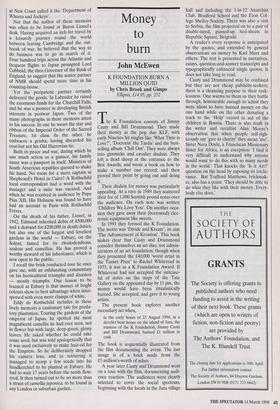Money to burn
John McEwen
K FOUNDATION BURN A MILLION QUID by Chris Brook and Gimpo Ellipsis, £14.95, pp. 252 he K Foundation consists of Jimmy Cauty and Bill Drummond. They made their money as the pop duo KLF, with early Nineties hit singles like 'What Time is Love?', Doctorin' the Tardis' and the best- selling album 'Chill Out'. They were always into gimmicks and cavalier disdain. They left, a dead sheep at the entrance to the Brit Awards; and wrote a book on how to make a number one record; and then proved their point by going out and doing it.
Their disdain for money was particularly appealing. At a rave in 1989 they scattered their fee of 1,000 Scottish pound notes over the audience. On each note was written `Children We Love You'. On another occa- sion they gave away their (borrowed) elec- tronic equipment like sweets.
In 1993 they formed the K Foundation. The motto was 'Divide and Kreate', its aim `The Advancement of Kreation'. This book makes clear that Cauty and Drummond consider themselves an art duo, not admin- istrators of an art foundation; though when they presented the £40,000 'worst artist in the Turner Prize' to Rachel Whiteread in 1973, it was as a K Foundation Award. If Whiteread had not accepted the suitcase- ful of notes on the steps of the Tate Gallery on the appointed day by 11 pm, the money would have been ritualistically burned. She accepted, and gave it to young artists.
The present book explores another incendiary act when, in the early hours of 23 August 1994, in a derelict boat house on the island of Jura, the trustees of the K Foundation, Jimmy Cauty and Bill Drummond, burned £1 million in cash.
The book is sequentially illustrated from the film documenting the event. The last image is of a brick made from the £1 million's-worth of ashes.
A year later Cauty and Drummond went on a tour with the film, documenting audi- ence reaction. The audiences were clearly selected to cover the social spectrum, beginning with the locals in the Jura village hall and including the 1-in-12 Anarchist Club, Bradford School and the Eton Col- lege Shelley Society. There was also a visit to Serbia, the film projected on to a pair of double-sized, pinned-up bed-sheets in Republic Square, Belgrade.
A reader's every response is anticipated by the quotes, and extended by general observations on money by Karl Marx and others. The text is presented in narratives, essays, question-and-answer transcripts and typographically enhanced single quotes. It does not take long to read.
Cauty and Drummond may be confused but they are not cheap publicity-seekers; there is a cleansing purpose to their reck- lessness. One warms to them as they battle through, honourable enough to admit they were idiots to have burned money on the one hand while on the other donating a track to the `Help' record in aid of the children in Bosnia. There is also truth in the writer and occultist Alan Moore's observation that when people self-righ- teously say 'give to charity' they mean 'me'. Sister Nora Doyle, a Franciscan Missionary Sister for Africa, is an exception: 'I find it very difficult to understand why anyone would want to do this with so many needs in the world.' That knocks the 'Is it Art?' question on the head by exposing its irrele- vance. But Trafford Matthews, brickmak- er, also has a point: 'They should be able to do what they like with their money. Every- body else does.'


































































 Previous page
Previous page